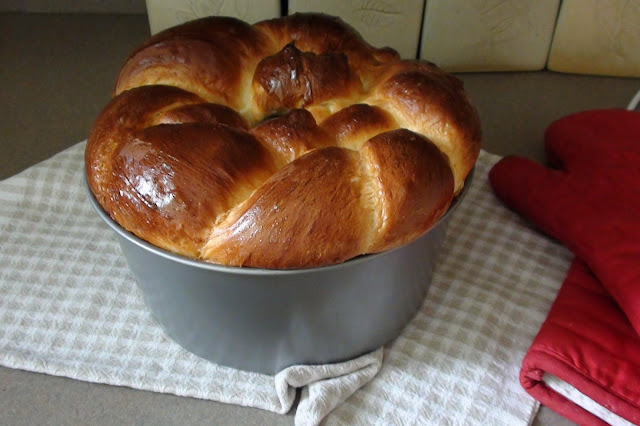You have to give it to Google translator; it has no clue when it comes to Hungarian adjectives. Take the word “foszlós”. It comes up as sleazy haha.
This is a milk-loaf with cotton candy lightness that rips into lofty strands of deliciousness. How it got to be this magnificent from all purpose flour? The answer lies in developing the gluten. By hand this takes 15 minutes of vigorous kneading, not quite as long with a powerful stand beater and dough hook. Also the loaf gets higher and loftier if baked in a pan with high sides. I used a large tube pan for this. It's less taxing on the beater to knead the dough in two batches.
LOFTY MILKY LOAF
3 cups whole milk
3/8 cup butter, melted
8-1/2 cups unbleached white flour
6 Tbsp sugar
1 tsp salt
3 tsp instant dry yeast
• Heat the milk to lukewarm.
• Melt the butter and whisk into the milk. Set aside.
• Place the flour in a large mixing bowl.
• Add the sugar, salt and the instant yeast and whisk to combine.
• Add the milk mixture and stir to combine.
• Knead the dough until ludicrously elastic. By hand knead vigorously for 15 minutes. In a stand beater with a dough hook knead each batch of dough for 8 minutes.
• [Your beater will probably not be able to handle the dough all at once, so knead it in 3 batches]
• Combine all the dough and knead it into a large mound.
• Butter a large mixing bowl and place the dough in it.
• Sprinkle the top with flour and set it aside to double.
• Preheat the oven to 400F.
• Butter a large tube pan generously, making sure the center flute and the corners of the pan are not missed. Or you may line the entire tube pan with parchment paper, it can be done.
• Turn the dough onto a board [with the floured top on the bottom].
• Cut the dough into 3 strands. Do not reroll the dough.
• Pulling and stretching lightly, bread the three strands.
• Place into the prepared tube pan and let it rise until the dough just about spills over the rim.
• Preheat the oven.
• Place the risen loaf in the oven and bake until nicely browned.
• Remove from the oven and let the cool down before removing from the pan.
• Slice and serve.








